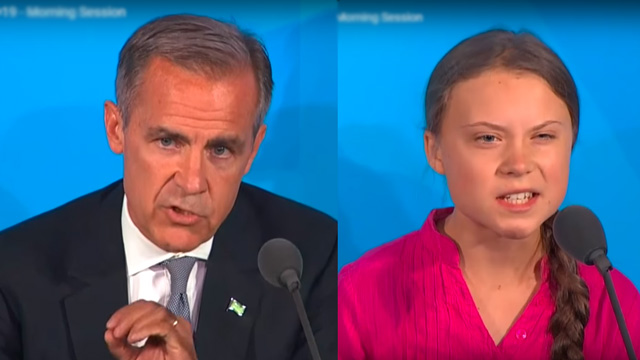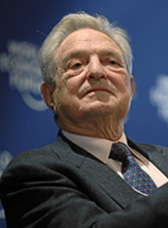The escalating push for a transition to a “sustainable economy” can only be understood in the context of the utter bankruptcy of the global financial system. In fact, it is the bankruptcy of the world’s financial system—the most powerful tool through which strategic control is exerted over nations—which is the primary issue. The attempt to salvage it under the auspices of a “low emissions economy” is merely a way to more effectively achieve the overall strategy of those who control it: starving large parts of the planet of the financing necessary to develop, while controlling global financial flows for their own ends.

This is not hyperbole. Mark Carney, the Governor of the Bank of
England, said as much in his key address to the UN Climate Action Summit
on September 23, 2019, where he announced a compact by the 130 top
banks to channel all investment into speculative “green” boondoggles,
while supporting the demands of the Paris Accord to shut down
three-quarters of the world’s thousands of coal-fired power plants by
2030—a policy which would send infant mortality up and lifespans down,
especially in the developing world, for lack of electricity. This would
be enforced via a set of new financial institutions such as the Green
Finance Initiative and the Task Force on Climate-related Financial
Disclosures.
This grouping is made of the same private banks, central banks, and policy makers who crashed the global economy in 2007-08. Nothing has fundamentally changed about how the global financial system is organized that would prevent another, even larger crash from occurring. Now, these same banking elites want you to believe that they are suddenly defenders of wildlife and stewards of the environment.
However, their goal is not to “save the planet” or to ensure a better future for people; it is to maintain the effectiveness of their primary means of exerting political control over the institutions and economies of the world.
Green Finance Timeline
2003: Institutional Investor Summit on Climate Risk takes place at the UN, members manage over $3 trillion in assets. Launches Investor Network on Climate Risk.
Chicago Climate Exchange begun as pilot project to trade greenhouse gas “credits.”
2004: Al Gore and David Blood found Generation Investment Management (aka Blood and Gore), along with partners from Goldman Sachs, to make money on the carbon trade.
2005: European Union Emissions Trading Scheme, the largest greenhouse gas emissions trading scheme in the world, starts up with 25 EU member nations. Today it involves 31 nations.
2006: British government commissions a 700-page report by the London School of Economics on the “economics of climate change” and how to build a Green Finance system.
The World Bank sets up a Carbon Finance Organization.
European Carbon Fund established in Luxembourg for carbon trading.
2007: Feb. 15, CEO of
Royal Dutch Shell Jeroen van der Veer calls for a global cap-and-trade:
“For more impact, the system must be global.”
Al Gore testifies in
front of Congress, and says, “Put a price on carbon… As soon as carbon
has a price, you are going to see a wave [of investment] in it.”
2015: Paris COP21 Conference launches the Green Financial System proposing a series of financial institutions:
-
The High-Level Expert Group on Sustainable Finance (HLEG)
Advises all EU institutions on policy to, as HLEG founder Christian Thimann says, “make sustainable finance a permanent part of Europe’s approach to governing capital.” -
The Network for Greening the Financial System (NGFS)
Made up of central banks representing over 50% of global GDP, includes other members such as the Bank for International Settlements and the World Bank. Its stated purpose: “To enhance the role of the financial system to manage risks and mobilize capital for green and low-carbon investments in the broader context of environmentally sustainable development.” -
The Green Finance Institute (GFI)
Created by the city of London to ensure they maintain control over the new green bubble. GFI CEO and former Barclays banker Rhian-Mari Thomas explains GFI’s mission: “To accelerate the domestic and global transition to a zero carbon and climate resilient economy through mobilizing capital.”
Who’s Financing Greenies? Multibillionaires.
“Taking money—yeah, we’ve got to take it.
It doesn’t matter that it comes from someone rich…. We’re dealing
with people who are crying at night, the same as we are…. So what does
a super rich person do? Commit suicide and burn all their money? No.
What we want them to do is do the decent thing: Ring us up, and give us
that million quid.”
—Extinction Rebellion co-founder Roger Hallam, August 2019
The same billionaires who aim to make
large profits with so-called “green finance” schemes for high-tax,
high-cost “renewable energy” technologies, have been mobilized to
finance the green movement. Here is a sampling:
 George Soros Billionaire mega-speculator and notorious economic hit-man, Soros famously called the time he worked with the Nazis in Hungary the happiest time of his life. |  Michael Bloomberg Bloomberg Philanthropies funds various green “activist” movements, and promises $500 million to shut down all coal plants in the United States by 2050. |
- The Tides Foundation a longtime clearing house of undisclosed super-rich donors, it has been a key funder of environmentalism since the 1970s. It has spun off many institutions such as the Environmental Working Group, environmental Media Services, and the Natural Resources Defense Council. In contributes to the Extinction Rebellion.
- The Rockefeller Brothers Fund established in 1940 by the six children of John D. Rockefeller, II. The RBF, a sort of private family think tank, has played a key role in developing the environmental movement for many decades. It has been key in funding the recent upsurge in “grassroots” activism.
- The Growald Family Fund founded by Paul Growald, husband of Eileen Rockefeller. Growald began his career as public relations representative for Paul Ehrlich of Population Bomb fame.
